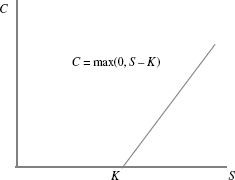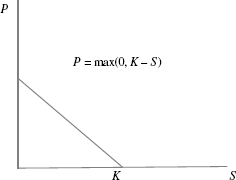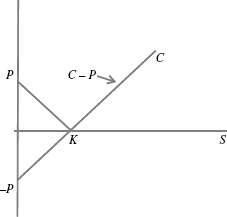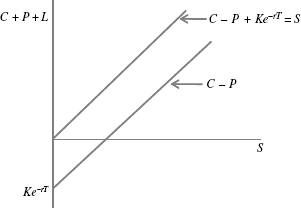Option Payoffs and Put-Call Parity
Suppose you own a call option on a stock that you can exercise at time T at strike price K. If the spot price S is less than K, the call has zero value and will not be exercised. If, on the other hand, the spot prices exceeds K, then the call will have value equal to the difference S – K. The value of this option is depicted in Figure 16.1. As S exceeds K, the option value C exceeds zero. Thus, the call option is worth either zero because it goes unexercised if S < K or it has positive value equal to the difference S – K in the event S > K.
Figure 16.1 Call Value at Expiration

Put value is positive when the spot price is less than the strike price. In the limit, if the spot price were zero, then the value of the put would be equal to the strike price. As the spot price increases, then value declines and when S > K, the put has zero value and will not be exercised. Figure 16.2 depicts this relationship.
Figure 16.2 Put Value at Expiration

These two simple relationships were used by Robert Merton and Fischer Black and Myron Scholes to describe the capital structure of the firm. Those arguments are now standard fare in all corporate finance texts. Consider the example of a firm whose assets are financed by equity (shares) and debt (bonds). With no loss of generality, assume the bonds are zero coupon bonds. When the debt matures, a principal payment equal to K is due. The owners of the firm (shareholders) compare the value of the firm's assets to K. If the asset value exceeds the debt obligation, they pay off the debt. Otherwise, they default on the debt and turn the assets over to the bondholders. Shareholders therefore have a European call option on the assets of the firm. To see this, let's denote the value of the bonds at maturity (time T) by K and the value of the firm's assets by AT. Shareholders therefore receive max ![]() while bondholders receive min (AT, K), which is the same as
while bondholders receive min (AT, K), which is the same as ![]() . The value of the debt K represents the strike price for the call option. At time
. The value of the debt K represents the strike price for the call option. At time ![]() , shareholders have a call option on the firm's assets while bondholders have the present value of the debt K minus a European put option on the firm's assets with a strike price of K. If the value of the firm's assets at time T exceeds K, the option will not be exercised. Otherwise, if K > AT, bondholders get
, shareholders have a call option on the firm's assets while bondholders have the present value of the debt K minus a European put option on the firm's assets with a strike price of K. If the value of the firm's assets at time T exceeds K, the option will not be exercised. Otherwise, if K > AT, bondholders get ![]() , the value of the firm's assets.
, the value of the firm's assets.
In sum, the value of the equity is identical to a call option while the value of the firm's debt is the present value of the debt minus the put option. Thus, if we denote the call and put, respectively, by c and p, then we can write the value of the firm's assets at time ![]() as:
as:
![]()
This says that the value of the assets must equal the total value of the securities used to finance the firm. Rearranging, we get the put-call parity condition:
![]()
Put-call parity therefore requires that a portfolio consisting of a call option on a share and a risk-free loan must equal the value of a portfolio consisting of a put option (with the same strike price as the call) and a share. The payout structure on this portfolio is illustrated in Figure 16.3.
More formally, put-call parity says that a combination of a put, a call, and risk-free loan have the same payout as the underlying stock. Using the parity relationship described earlier, we get a condition for stock prices:
![]()
That is, buying one call on a share of stock, selling one put (both at the same strike price), and lending an amount ![]() constitutes a portfolio that replicates the value of the stock. The combination of the put and call has the payout shown in Figure 16.3.
constitutes a portfolio that replicates the value of the stock. The combination of the put and call has the payout shown in Figure 16.3.
Figure 16.3 Combination of Put and Call

Adding the loan to the replicating portfolio produces a payout that is identical to S, as shown in Figure 16.4.
Figure 16.4 Put, Call, and Loan

